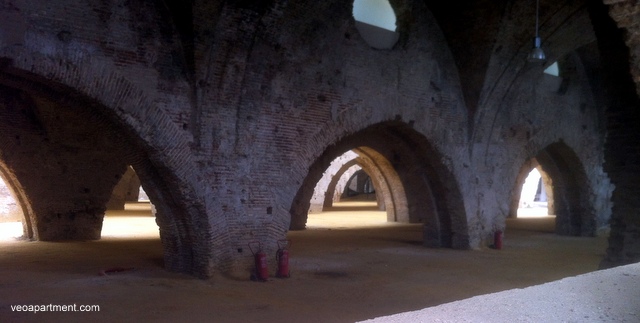Las Atarazanas Reales de Sevilla (Royal dockyards of Seville) are probably one of the least visited major historic buildings in Seville (indeed, at the present time it’s not possible to go inside, only to view it from outside), but it’s appearance and history make it well worth going to see.

Exterior of the Atarazanas – “Looks like there’s a storm brewing, Captain!”
The atarazanas were built in 1252, just four years after the reconquest of the city by the Christians, by king Alfonso X, for the construction of the galleys needed by the Spanish to guard the Straits of Gibraltar against the Moors and protect Spanish shipping in the Mediterranean. There were originally seventeen naves, and up to thirty ships could be constructed at the same time, but now only seven remain in more or less their original condition. They can be found along the outside of the stretch of city wall by the Postigo del Aceite (Oil Gate), and once continued as far as the Postigo del Carbón (Coal Gate) and the Torre del Plata.

Interior of the Atarazanas – naves and arches
They were constructed entirely of brick, in a style now known as Mudejar-Gothic, with vaulted ceilings and wide arches connecting the naves. The best view of the interior is to be had from the windows just beyond the Oil Gate, from where you can see the arrangement of the naves and arches, giving a perspective reminiscent of the Mezquita in Cordoba, as well as a section of the old city wall that forms the back of the dockyard enclosure. In late mediaeval times the area between the dockyards and the river was open sand and mud, allowing completed ships to be hauled to the river.
Because of their size, and the fact that the required rate of shipbuilding rarely utilised the whole building, the Atarazanas were used for many different purposes during their long life, including everything from public festivals to customs sheds, storing loot and holding prisoners of war from the conflicts with the Moors, and later as a fish market.

Entrance to La Maestranza de Artillería
Perhaps surprisingly, it was just after the discovery of the Americas in 1492 that the shipyards went into decline, probably because the galleys they were designed for had been superseded by newer designs, and the incorporation of Aragon into a united Spain had made cheaper shipyards in Barcelona and Valencia available for the building of the navy’s ships. In 1641 five of the naves were converted for use as a Charity Hospital, and in 1719 the seven naves we can still see became officially the headquarters of La Maestranza de Artillería, and were used for the manufacture, storage of artillery and for offices of the administration of the army until as late as 1970. The façade that can still be seen today was built in 1782, and the chimney, now used only by nesting storks, also belongs to this period. Finally, in 1945, the five naves at the Torre del Plata end of the complex were totally demolished to make way for new government offices.
Although currently disused, there are plans (albeit vague) to bring the Atarazanas back into public use. They are certainly far too remarkable, both in themselves and as part of Seville’s heritage, to be abandoned.

Local resident in the courtyard of the Atarazanas
If you are interested in this part of Seville and its history, we have a variety of holiday apartments in this part of Seville that are a perfect base for exploring the riverside area.